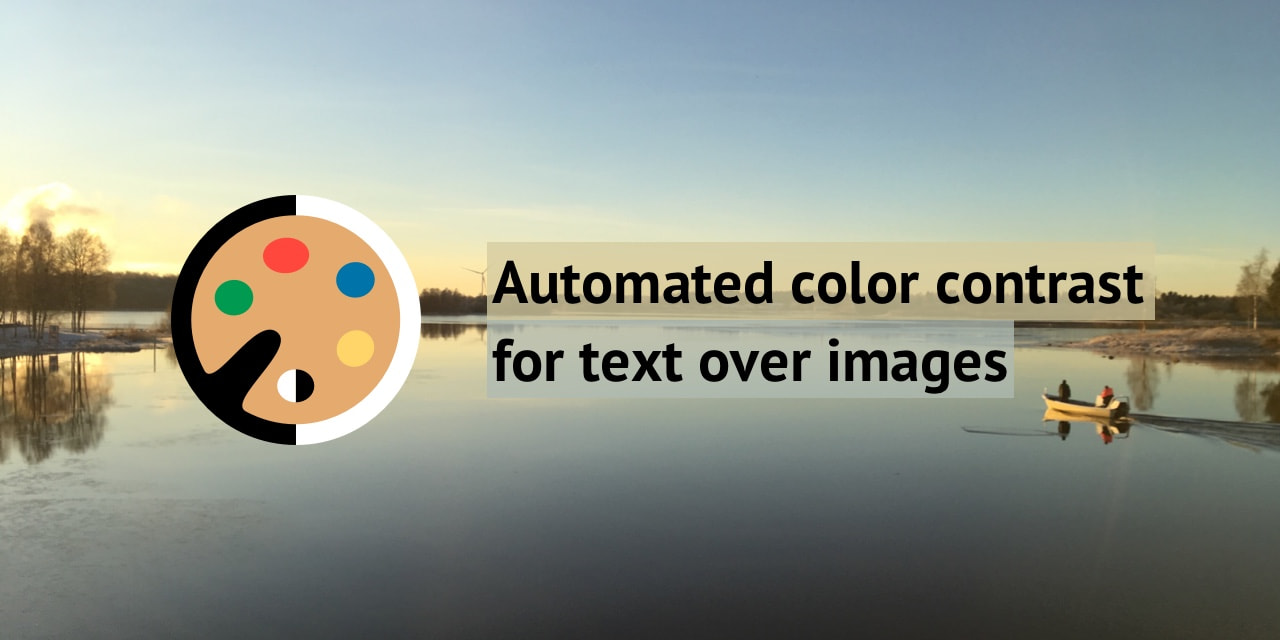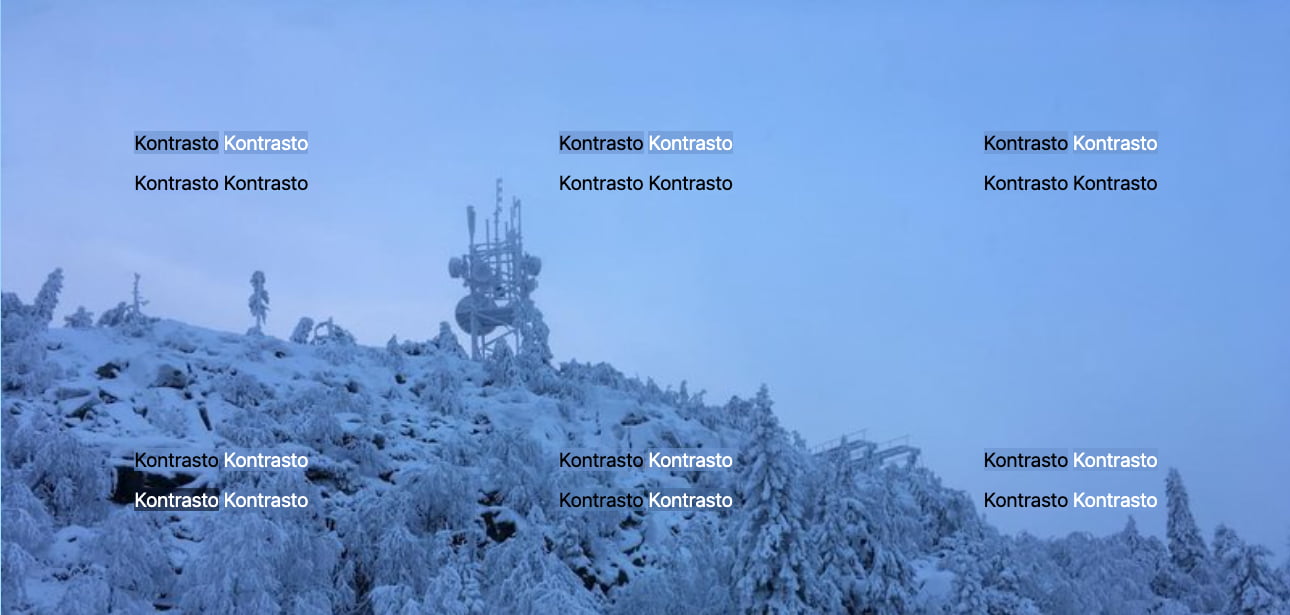kontrasto
 kontrasto copied to clipboard
kontrasto copied to clipboard
🎨 Automated color contrast for text over images
Kontrasto 
Why we need this
Kontrasto is a dual Python and JavaScript library which analyses instances of text over images, and transforms the text to make it more readable and have a higher contrast against the background.
Using Kontrasto both server-side and client-side gives the best results: server-side processing means users will have the best possible styles as the page loads, while client-side processing can refine the result based on the final position of the text over the image.
Here is a demo, over different areas of an image, with different methods of dominant color extraction and contrast ratio calculation:
Check out our live demo for other examples.
Usage in Python
kontrasto is available on PyPI.
# Assuming you’re using Python 3.6+,
pip install kontrasto
The simplest way to try it out is to use the command-line interface:
kontrasto --text '#00ff00' demo_images/blue-sky-cliffs.jpg
This will extract the image’s dominant color, and compare it against three text colors: white, black, and the provided #00ff00. Here is a sample result:
- Dominant color:
#4971a1(https://whocanuse.com/?b=4971a1&c=&f=16) - WCAG 2 contrast black: 4.16:1 (AA large only, https://whocanuse.com/?b=4971a1&c=000000&f=16)
- WCAG 2 contrast white: 5.05:1 (AA, AAA large, https://whocanuse.com/?b=4971a1&c=ffffff&f=16)
- WCAG 2 contrast text color: 3.68:1 (AA large only, https://whocanuse.com/?b=4971a1&c=00ff00&f=16)
- WCAG 3 contrast black: 29.158302335633827
- https://whocanuse.com/?b=4971a1&c=000000&f=16
- WCAG 3 contrast white: 82.7306051896947
- [(18, 400), (16, 500)]
- https://www.myndex.com/APCA/?BG=4971a1&TXT=ffffff
- https://whocanuse.com/?b=4971a1&c=ffffff&f=18
- https://whocanuse.com/?b=4971a1&c=ffffff&f=16
- WCAG 3 contrast text color: 60.98703767172198
- [(24, 400), (18, 500), (16, 600)]
- https://www.myndex.com/APCA/?BG=4971a1&TXT=00ff00
- https://whocanuse.com/?b=4971a1&c=00ff00&f=24
- https://whocanuse.com/?b=4971a1&c=00ff00&f=18
- https://whocanuse.com/?b=4971a1&c=00ff00&f=16&s=b
From there, we can move onto more serious use cases!
Usage in vanilla Python
Import the low-level methods and enjoy:
from kontrasto import wcag_2, wcag_3
from kontrasto.convert import to_hex
from kontrasto.contrast import get_dominant_color
from PIL import Image
def wcag_2_contrast_light_or_dark(
image, light_color: str, dark_color: str
) -> Dict[str, str]:
dominant = to_hex(get_dominant_color(image))
light_contrast = wcag_2.wcag2_contrast(dominant, light_color)
dark_contrast = wcag_2.wcag2_contrast(dominant, dark_color)
lighter = light_contrast > dark_contrast
return {
"text_color": light_color if lighter else dark_color,
"text_theme": "light" if lighter else "dark",
"bg_color": dominant,
"bg_theme": "dark" if lighter else "light",
}
def wcag_3_contrast_light_or_dark(
image, light_color: str, dark_color: str
) -> Dict[str, str]:
dominant = to_hex(get_dominant_color(image))
light_contrast = wcag_3.format_contrast(
wcag_3.apca_contrast(dominant, light_color)
)
dark_contrast = wcag_3.format_contrast(
wcag_3.apca_contrast(dominant, dark_color)
)
lighter = light_contrast > dark_contrast
return {
"text_color": light_color if lighter else dark_color,
"text_theme": "light" if lighter else "dark",
"bg_color": dominant,
"bg_theme": "dark" if lighter else "light",
}
Usage in Wagtail
In Wagtail, using Kontrasto is much simpler:
- The result of dominant color extraction is cached, greatly improving performance.
- The above methods are directly available as template tags.
At least for now, this does mean using Kontrasto requires adding a field to a custom image model:
from wagtail.images.models import (
AbstractImage,
AbstractRendition,
SourceImageIOError,
)
from kontrasto.willow_operations import pillow_dominant
class CustomImage(AbstractImage):
dominant_color = models.CharField(max_length=10, blank=True)
admin_form_fields = Image.admin_form_fields
def has_dominant_color(self) -> bool:
return self.dominant_color
def set_dominant_color(self, color: str) -> bool:
self.dominant_color = color
def get_dominant_color(self):
if not self.has_dominant_color():
with self.get_willow_image() as willow:
try:
self.dominant_color = pillow_dominant(willow)
except Exception as e:
# File not found
#
# Have to catch everything, because the exception
# depends on the file subclass, and therefore the
# storage being used.
raise SourceImageIOError(str(e))
self.save(update_fields=["dominant_color"])
return self.dominant_color
class Rendition(AbstractRendition):
image = models.ForeignKey(
"CustomImage", related_name="renditions", on_delete=models.CASCADE
)
class Meta:
unique_together = (("image", "filter_spec", "focal_point_key"),)
Then, in templates:
{% wcag_2_contrast_light_or_dark page.test_image "#ffffff" "#000000" as result
%} {% wcag_3_contrast_light_or_dark page.test_image "#ffffff" "#000000" as
result_3 %}
<div
data-banner
style="--kontrasto-text:{{ result_3.text_color }}; --kontrasto-bg:{{ result_3.bg_color }}99;"
>
{% image page.test_image width-800 loading="lazy" data-banner-image="true" %}
<p>
<span class="kontrasto-text-bg" data-banner-text>{{ demo_text }}</span>
</p>
</div>
This additionally relies on the following CSS, for the simplest integration with client-side processing:
.kontrasto-text-bg {
color: var(--kontrasto-text);
background: var(--kontrasto-bg);
}
Usage in JavaScript
kontrasto is available on npm for client-side (browser) JavaScript. This option makes it possible to only extract the dominant color of images where the text appears, which leads to much better results. However, it has the caveat of executing in the users’ browser, which has a clear performance cost.
npm install kontrasto
Using it in JavaScript is slightly different.
Vanilla JavaScript
Here is a basic vanilla JavaScript integration:
import {
wcag_2_contrast_light_or_dark,
wcag_3_contrast_light_or_dark,
} from "kontrasto";
const banner = document.querySelector("[data-banner]");
const bannerImage = banner.querySelector("[data-banner-image]");
const bannerText = banner.querySelector("[data-banner-text]");
const contrast = wcag_3_contrast_light_or_dark(
bannerImage,
"#ffffff",
"#000000",
bannerText,
);
banner.style.setProperty("--kontrasto-bg", `${contrast.bg_color}99`);
banner.style.setProperty("--kontrasto-text", contrast.text_color);
This assumes an HTML structure like:
{% wcag_2_contrast_light_or_dark page.test_image "#ffffff" "#000000" as result
%} {% wcag_3_contrast_light_or_dark page.test_image "#ffffff" "#000000" as
result_3 %}
<div
data-banner
style="--kontrasto-text:{{ result_3.text_color }}; --kontrasto-bg:{{ result_3.bg_color }}99;"
>
{% image page.test_image width-800 loading="lazy" data-banner-image="true" %}
<p>
<span class="kontrasto-text-bg" data-banner-text>{{ demo_text }}</span>
</p>
</div>
And CSS:
.kontrasto-text-bg {
color: var(--kontrasto-text);
background: var(--kontrasto-bg);
}
Combined with the server-side integration, this makes it possible to deliver both the best possible performance, and the best possible text contrast enhancement.
Particular considerations
TODO
React
TODO
Contributing
See anything you like in here? Anything missing? We welcome all support, whether on bug reports, feature requests, code, design, reviews, tests, documentation, and more. Please have a look at our contribution guidelines.
If you just want to set up the project on your own computer, the contribution guidelines also contain all of the setup commands.
Credits
Image credit: FxEmojis. Test templates extracted from third-party projects. Website hosted by Netlify.
View the full list of contributors. MIT licensed. Website content available as CC0.





